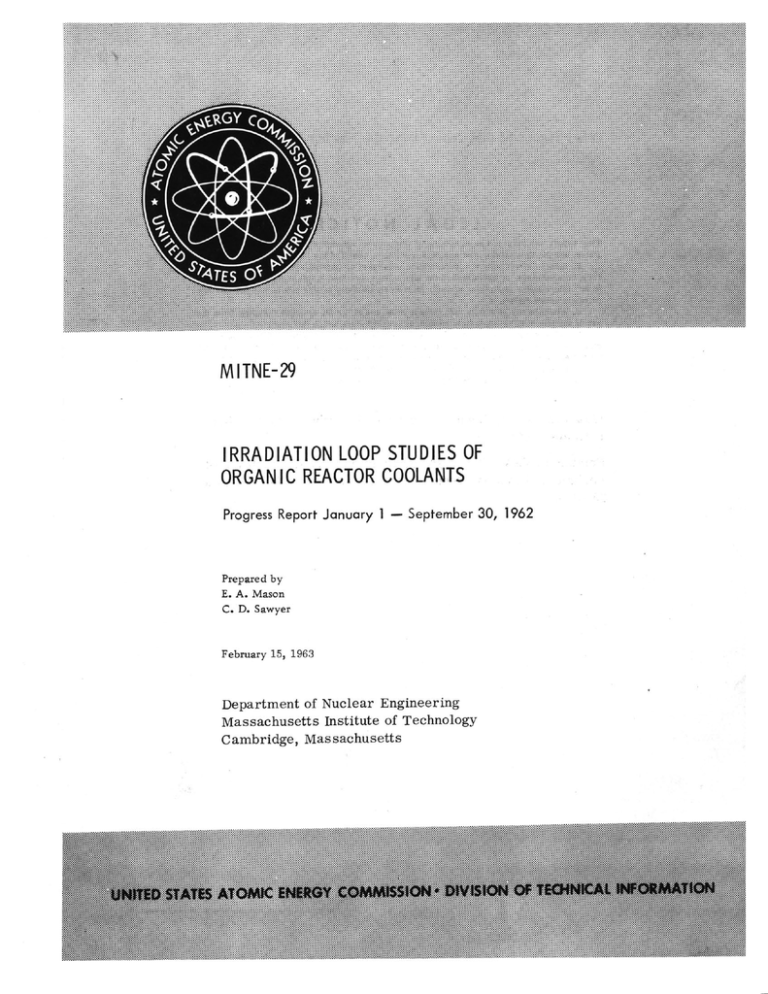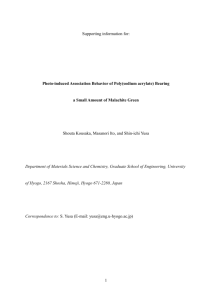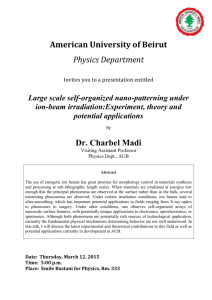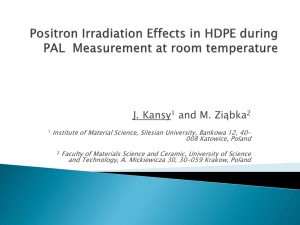MITNE-29 STUDIES ORGANIC 30, 1962
advertisement

MITNE-29 IRRADIATION LOOP STUDIES OF ORGANIC REACTOR COOLANTS Progress Report January 1 - September 30, 1962 Prepared by E. A. Mason C. D. Sawyer February 15, 1963 Department of Nuclear Engineering Massachusetts Institute of Technology Cambridge, Massachusetts Other issues of this report bear the number IDO-11106. LEGAL NOTICE This report was prepared as an account of Government sponsored work. Neither the United States, nor the Commission, nor any person acting on behalf of the Commission: A. Makes any warranty or representation, expressed or implied, with respect to the accuracy, completeness, or usefulness of the information contained in this report, or that the use of any information, apparatus, method, or process disclosed in this report may not infringe privately owned rights; or B. Assumes any liabilities with respect to the use of, or for damages resulting from the use of any information, apparatus, method, or process disclosed in this report. As used in the above, "person acting on behalf of the Commission" includes any employee or contractor of the Commission, or employee of such contractor, to the extent that such employee or contractor of the Commission, or employee of such contractor prepares, disseminates, or provides access to, any information pursuant to his employment or contract with the Commission, or his employment with such contractor. This report has been reproduced directly from the best available copy. Printed in USA. Price $0.75. Available from the Office of Technical Services, Department of Commerce, Washington 25, D. C. USAECDivision of Technical InformationExtension, Oak Ridge,Tennessee MITNE- 29 REACTOR TECHNOLOGY IRRADIATION LOOP STUDIES OF ORGANIC REACTOR COOLANTS PROGRESS REPORT JANUARY 1-SEPTEMER 30, 1962 ISSUED: February 15, 1963 Report prepared by: E. A. Mason, Project Supervisor C. D. Sawyer Contributors: W. N. T. W. J. P. T. J. E. J. R. A. Bley Carroll Casey Swierzawski Fahimian Chin DEPARTMENT OF NUCLEAR ENGINEERING MASSACHUSETTS INSTITUTE OF TECHNOLOGY CAMBRIDGE 39, MASSACHUSETTS (M.I.T. Project No. DSR 8710) Work Performed Under Contract No. AT(10-1)-1067 with the Idaho Operations Office U. S. ATOMIC ENERGY COMMISSION TABLE OF CONTENTS Page 1.0 2.0 Abstract Summary of Loop Operation Results 2.1 Physical and Chemical Properties 2.11 Density and Viscosity 2.12 2.13 2.14 2.15 2.2 2.3 Carbon-Hydrogen Ratio Ash and Semi-Quantitative Emission Spectroscopy Number Average Molecular Weight Gas Composition and Evolution Rate Heat Transfer Radiation Stability 3.0 4.0 Future Plans Reports 5.0 6.0 Nomenclature References 1 3 3 3 6 6 7 9 9 16 18 19 20 21 iii FIGURES Page Figure 1 Figure 2 Figure 3 Figure 4 Figure 5 Figure 6 Figtre 7 Figure 8 Density of Santowax OMP Irradiated at 600 0 F Versus Megawatt-Hours of Reactor Operation Viscosity of Santowax OMP Irradiated at 600OF Versus Megawatt-Hours of Reactor Operation Number Average Molecular Weight Santowax OMP Irradiated at 600 0 F Versus MegawattHours of Reactor Operation Santowax OMP Heat Transfer Data From the 600 0 F Irradiation Santowax OMP Heat Transfer Data From the 600 0 F Irradiation Comparison of Santowax OMP Heat Transfer Data Taken During the 600OF Irradiation at Different Heat Fluxes Comparison of Santowax OMP Heat Transfer Data Thken During the 600oF Irradiation at Different Heat Fluxes Cumulative Grams of HB Removed From the Loop During the Second Steady-State-HB Period of the 600 0 F Irradiation Versus Megawatt-Hours of Reactor Operation 4 5 8 11 12 14 15 17 TABLES Table I Summary of Loop Operation Through September 30, 1962 2 Table II Ash and Emission Analyses From 600 0 F Irradiation 7 Table III Range of Variation of Major Heat Transfer Variables 10 Table IV Comparison of Heat Transfer Correlations With Data Taken at Different Values of Q/A iv 13 A B S T R A C T During the period covered by this report, January through September, 1962, a constant HB level of about 33 weight % was maintained in the loop in order to study the long-term effects on the physical and chemical properties of Santowax OMP under in-pile irradiation at 600 0 F. Much of the analysis of the data is still underway so that the results included in this report should be treated as preliminary in nature. The density, viscosity and number average molecular weight of the coolant during the steady-state-HB period were found to be approximately constant, implying that a steady level in these variables can be maintained during a long-term irradiation. The heat transfer data agree very well with results reported in the literature L6,7). A maximum limit on the scale resistance built up over one year of operation appears to be less than 10% of any of the measured heat transfer resistances from the heater wall to the bulk coolant. Data taken from the steady-state-HB period indicate a HB production rate of 0.7 gms HB/MWH of reactor operation or a value of G(-+HB)=0.15 at 33% HB. v 1 Summary of Loop Operation The 600 F irradiation of Santowax OMP was divided into two distinct periods. The first period, which will be termed the transient period* began on August 9, 1961. During this phase a given initial amount of Santowax was allowed to degrade with periodic sampling but no makeup. Due to changes 1.0 in density of the coolant, and to sampling, it became necessary on October 5, 1961 to add fresh Santowax OMP in order to continue the irradiation. After this addition, the transient operation was resumed and continued until January 3, 1962 at which time the coolant contained about 60% DP. Further details on the loop operation during this phase may be found in reference (1). An interim period of about one month followed, during which the coolant composition was changed from 60% DP to 33% by about 40% DP and the HB content lowered to nar coolant withdrawal and addition of unirradiated Santowax OMP. The second period, which will be termed the steady-stateHB period, began January 30, 1962. The object of this phase was to maintain a constant HB fraction of about 33 weight % in the coolant and to study the long-term irradiation effects on the physical and chemical properties of the coolant. In order to maintain the HB level, samples containing about 300 grams of coolant were removed from the loop at regular intervals and were distilled. Each distillate was mixed with fresh Santowax OMP and returned to the loop before the next sample was removed. The steady-state-HB operation was divided into two parts by a failure of the main circulating The spare pump was put pump (Chempump) on March 28, 1962. on stream and the fresh Santowax OMP it contained was added at that time. The HB content did not level out at 33% again *In previous reports (1,2) this period has been referred to as that of batch optration, but this name is being dropped since the sample removal and some make-up addition took place during the period. 2 until May 24, 1962, at which time the steady--state-HB operation was resumed and continued through September 30, 1962, Table I summarizes the operation of the loop through September 30, 1962. Table I Summary of Loop Operation Through September 30, Loop Operation Dates Exposure (Reactor MWH) 1962 %DP Range Transient No. 1 Transient No. 2 8/9/61-10/5/61 o - 1623 o to 40 10/5/61-1/3/62 33 to 60 Steady-State-HB No. 1 Steady-State-HB No. 2 1/30/62-3/28/62 1623 - 3890 4630 - 6233 5/24/62-9/30/62 7880-11,195 3 2.0 Results It has been found desirable to re-evaluate the data presented in the last two reports (1,2) for the period of transient operation together with the data of the steadystate-HB period of operation obtained during February through September, 1962. This re-evaluation is 8till in progress, but some of the preliminary results will be presented here. Since most of the results require repetitive calculations and a statistical interpretation, an IBM 7090 computer is being utilized to help with the data reduction. 2.1 Physical and Chemical Properties 2.11 Density and Viscosity Figures 1 and 2 plot the density and viscosity of Santowax versus the reactor exposure scale of megawatt-hours. This variable is quite convenient since it allows the calculation of properties of the coolant on any given day from the beginning of the irradiation. Such information is needed, for example, in the calculation of the heat transfer propDue to the nature erties of the coolant (see Section 2.2). of the equipment measuring the densities and viscosities, the data for a given sample are not taken at precisely 400 0 F, 500 0 F, 6000 F, 7000F and 800 0 F. The data points displayed on Figures 1 and 2 represent interpolated and extrapolated values calculated from the density and viscosity data for each sample, assuming that the sample density decreases linearly with temperature and that its viscosity obeys the relation p=0eeK/ (T in degrees Rankine). Also shown parametrically on Figures 1 and 2 is the DP concentration at various intervals. Density and viscosity are seen to increase during both periods of transient operation, as the concentration of degradation products increased. The density and viscosity of the coolant during the steady-state-HB part of the irradiation were relatively constant, implying that a steady-state level can be maintained in these properties during a long-term irradiation. 0~ 0~ 0 0 a~O~ 0 0 0 0 0 a0 0 0 +* 000 0l. 0 0~ 0 0* 0 0e 0 4* I.0H -- 0 0 0 - -0-o 0 0.. c a.0 - 0- - - -. o..7--o 400 *F 0 -0--*--0 0.9 -0 0-- 0 0 00 -Q - - 0 600*F 0 0 500*F 00( 0 tI n 0 --- --- o 700*F 0--- 00 z Lq 0 0 0 0 800*F 0 0.8 F STEADY-STATE 0 FIGURE END OF TRANSIENT END OF TRANSIENT NO. I NO. 2 1000 I 2000 3000 -HB NO. I 4000 5000 6000 7000 MWH OF REACTOR OPERATION h+STEADY-STA NO. 2-+ 8000 9000 10,000 11,000 DENSITY OF SANTOWAX OMP IRRADIATED AT 600 *F VERSUS MEGAWATT-HOURS OF REACTOR OPERATION (. o 6.0 o a.. . O 0 0 0 0 '4.lq I. 0- a.00 0. 0 0 a. 0 a. O 0 0 It 0- O 0- 0 U) 0. a 0 It- 4. o o o0. Wl w "ro_00 Tr 2.0 I 0 0 0 400*F 0 z 0 w 0 500*F 0- z 1.0 .9 0.90 0 0 0.8 - -6-o-00 W 0.6 0 cf) 00 END OFT 0.2 TRANSIENT NO. I 0 1000 2000 0 00 STEADY-STATE -HB NO. I 600*F 0 700 *F o 0 0.4 -.a-o-- 0 800*F 0 F-STEADY-STATE-HB - NO. 2 -* TRANSIENT 1 3000 NO. 2 4 5 6 7 8 90 4000 5000 6000 7000 8000 9000 I I 10,000 11,000 MWH OF REACTOR OPERATION FIGURE 2 VISCOSITY OF SANTOWAX OMP IRRADIATED AT 600*F VERSUS MEGAWATT-HOURS OF REACTOR OPERATION 6 At this point it is appropriate to mention the criteria used to determine whether the steady-state-HB period constituted a long-term irradiation or not. The first criterion used was the irradiation time required to process (through the distillation column) the entire mass of coolant in the loop once. For the 600 0 F irradiation this time is equivalent to about 2200 MWH of reactor operation, so that the coolant in the loop during the steady-state-HB run has been processed about two and one half times. The second criterion is the irradiation time required to replace the entire loop mass once. Since the HB content of the loop is 33 weight % it can be seen that during the steady-state-HB period the coolant in the loop has been replaced approximately once. 2.12 Carbon-Hydrogen Ratio Analyses for carbon and hydrogen were performed periodically throughout the 600 0F irradiation, including the transient phase in which the %DP varied from 0 to 60%. The average values are 94.0% C and 6.0% H, giving a C/H ratio of 15.7 : 1. The data show no statistical change in the ratio, with the maximum range in both C and H concentrations being +0.4%. 2.13 Ash and Semi-Quantitative Emission Spectroscopy Ash analyses were performed on 5 gram samples of coolant from the loop, after which the residue of the ashing was analyzed by emission spectroscopy for individual components. Shown in Table II are representative ash and emission analyses taken from the beginning, middle, and end of the 600 0 F irradiation. Since the emission analyses are semi-quantitative, all that can be said about the results is that no one element is present in an amount greater than 10 ppm. Because of the relatively small size samples used for ashing the probable error in the results is about 100 ppm. Thus, the main conclusion to be drawn from the ash analysis is that there is no large amount of ash present. 7 Table II Ash and Emission Analyses from 600 0 F Irradiation Sample Reaor Al Cu Fe Ng Mn Na Ni 1-3 2 3 /3 /3 2-7 <'2 (2 2 .2 2-5 c2 269 10579 *Conditions for ashing: 90 minutes at 1000 0 C. 35 116 .392 3839 2.14 .2 2-4 -- Si (ppm 3-9 90 2-7 2-5 14 0 Number Average Molecular Weight Molecular weights were determined cryoscopically using diphenyl ether as a solvent by Monsanto Research Corporation (Everett, Mass.) and through the use of a MECHROLAB OSMONETER, MODEL 301A using tetrahydrofuran as a solvent in our own laboratory. The results are given in Figure 3. During the first steady-state-HB operation the HB content of the coolant varied from 35 to 31 % and this fluctuation is reflected in the molecular weights reported for this period. During the second steady-state period better control on the HB content was maintained (+0.5%). The constancy of the molecular weight is an indication that a steady-state level has been reached during this period. The number average molecular weights of the distillation bottoms (essentially the high boiling fraction of the coolant) have been determined, and most values range between 600 and 750. The results obtained are not within the limits of precision of the instrument and additional analyses will be performed to better define the molecular weight of HB fraction. Attempts are being made to separate the HB into various fractions by sublimation on several of the samples of the bottoms from the second steady-state-HB period. These fractions will be subsequently analyzed by gas chromatography, and the molecular weights of the fractions measured in order to determine if the HB fractions of the coolant reached a constant composition during the period of steady-state-HB operation. 400 400 I I I 0 * 0 I w 300 [- F- 0 0 * 0 0 * 09oo 0 e 200 0 0 I. 2L I I END OF TRANSIENT NO. I STEADY-STATE -HB NO. I 4- STEADY-STATE-H B NO.2 j4- END OF TRANSIENT NO. 2 w w m 100 * MONSANTO z o MIT 0 0 1000 - ' 2000 . ' ' ' i I 3000 4000 5000 6000 7000 8000 9000 10,000 MEGAWATT-HOURS OF REACTOR OPERATION 11,000 FIGURE 3 NUMBER AVERAGE MOLECULAR WEIGHT SANTOWAX OMP IRRADIATED AT 600*F VERSUS MEGAWATT-HOURS OF REACTOR OPERATION 9 2.15 Gas Composition and Evolution Rate Data on gas composition and rate of evolution have been taken during the 6000F irradiation. Analysis of the data is continuing and some results should be available for the next progress report. 2.2 Heat Transfer An IBM 7090 computer program has been written to correlate the data taken on rates of convective heat transfer using the test heaters at the loop (2) in terms of dimensionless properties and to perform a least squares analysis on these properties assuming a relation of the form Nu = A (Re)B (Pr)C (a) D (l) where the symbols are defined in Section 5.0. After the least squared values of A, B, C and D have been found, the program performs a Wilson plot analysis (2) for heat transfer resistance due to any scale or film which may have built up. The Wilson plot takes advantage of the following relations concerning the heat transfer from the wall to the fluid: U = I+ h h5 h f= K(MIH)VB (2) (3) where the properties of the fluid have all been lumped into K, and K has been made a function of MWH. Therefore a plot of 1/U versus 1/VB for the data taken on a given day should yield as intercept 1/h . The physical property data for density and viscosity were obtained from measurements at MIT. Data on the thermal conductivity and specific heat of the irradiated coolant are not yet available, so the data available for unirradiated Santowax R (3,L) were used. Gercke (5) has obtained some data on irradiated Santowax R which indicate that the variation in 10 the heat capacity due to irradiation will be less than 7%, and that the variation in the thermal conductivity due to irradiation will be less than 5%. Table III gives the range of variation of the major variables associated with the heat transfer data taken during the 600 0 F irradiation of Santowax OMP. Table III Range of Variation of Major Heat Transfer Variables Variable Range Heat flux, Q/A 3x10 4 - 2xl0 5 Btu/hr ft 2 Velocity, V Heat transfer coefficient, U Nusselt No., Nu 5 - 20 ft/sec Reynolds No., Re Prandtl No., Pr 7x10 3 (4/4) 1.2 - 2.0 330 - 2400 Btu/hr ft 2 oF 90 - 625 - 105 7 - 36 Three specific problems were given the computer. The first was to use Equation (1) to determine A by a leastsquareo analysis using B=0.8, C=0.4 and D=0 (the Dittus-Boelter relation). The result of this calculation for all the heat transfer data of the 6000 F irradiation with Santowax OMP was Nu = 0.023(Re) '8 (Pr)o.4 +6.6% (4) where the deviation quoted is a root-mean-square deviation. The proportionality constant A=0.023 is in very good agreement with other heat transfer correlations reported in the literature (6,:). A plot of this analysis is given in Figure 4. Since the slope of the Dittus-Boelter line drawn on Figure 4 appeared to be too low, compared to the data, the computer was also asked to use Equation (1) with D=0 and A, B and C to be obtained by a least squares analysis. The result was Nu = 0.0020 (Re) 1" 0 (Pr) 0 .5 5 +3.7% (5) A plot of the data in the form of Equation (5) is given in Figure 5. Although this relation does give a slightly better 11 I I ! I I I I i i ' i a i I I ' *' - 102 z 10 0.023 Reo-8 Pro Nu I a I a a a 4 a I I I I I 10 4 Re FIGURE 4 SANTOWAX OMP HEAT TRANSFER DATA FROM THE 600*F IRRADIATION 12 a102 Nu =0.0020 Re 1.0 Pr o.55 .. 10 Re FIGURE 5 SANTOWAX OMP HEAT TRANSFER DATA FROM THE 600*F IRRADIATION 13 fit to the data, we have not yet been able to explain this apparent first power dependence on Reynolds' Number as compared to the large volume of heat transfer data in the literature which indicates a 0.8-power dependence. Another unusual effect of acceptance of the apparent first-power dependence on Reynolds' Number is that the familiar Reynolds' Analogy would then predict that the friction factor would Possible sources of be independent of Reynolds' Number. small consistent errors in the experimental and data analysis procedures are therefore now being studied. Finally, a computer analysis of the data, least squaring A, B, C and D (generalized Sieder-Tate relation), was performed. The result was Nu = 0.018 (Re) 1 0 (Pr)0.50 )0_*039 +4.3% (6) Ow // Since the range of (p/pw) was over the small range 1.2 to 2.0 and since the viscosity of the coolant at the wall temperatures (750-9500 F) is not well known, Equations (4) and (5) are at present preferred. In order to test the dependence of the data on the heat flux, Q/A, data taken during the same period at two different heat fluxes of 105 and 2x10 5 Btu/hr ft 2 were analyzed separarately. Figure 6 compares the analyses for the Dittus-Boelter type relation (see Equation (4)) and Figure 7 compares the analyses for the relation Nu = A ReB PrC with A, B and C being obtained by least-squaring. The results for these two correlations are tabulated in Table IV. It can be seen from Table IV that within the deviations cited no affect of Q/A on the heat transfer correlations was observed. Table IV Comparison of Heat Transfer Correlations with Data Taken at Different Values of Q/A Qr ft2 A B C deviation, % 105 2xlo 5 105 2xlo 5 0.0241 0.0253 0.00204 0.00206 0.8 0.8 1.0 1.0 o.4 0.4 0.55 0.55 +5.0 +4.3 +2.0 +2.0 14 200- Q/A = 200,000., 0 8 Pr 0 .4 Nu = 0.0253 Re 6 Nu + Q/A= 100,000 0.0241 Re 0- Pr 0.4 z ++ + 44. Q/A = 200,000 Btu/hr/ft 2 4.4. Q/A = 100,000 Btu/hr/ft 2 50 2x10 4 5 x104 105 Re FIGURE 6 COMPARISON OF SANTOWAX OMP HEAT TRANSFER DATA TAKEN DURING THE 600*F IRRADIATION AT DIFFERENT HEAT FLUXES 15 200 tc, 100 z 40 2x10 4 5x10 4 Re FIGURE 7 COMPARISON OF SANTOWAX OMP HEAT TRANSFER DATA TAKEN DURING THE 600*F IRRADIATION AT DIFFERENT HEAT FLUXES Wilson plot data are currently being analyzed to see if there was a statistically significant buildup of scale resistance with time during the 600 0 F irradiation. At this time, a maximum limit on the scale resistance built up after one hr ft2 0F/Btu, or year of operation can be placed at 10~ less than 10% than any of the heat transfer resistances which have been measured. 2.3 Radiation Stability Variations in performance of the chromatograph over the long period of transient and steady-state-HB operations have introduced some scatter in the coolant analyses. Consequently many of the samples from the 6000F irradiation are being reanalyzed. This process is still underway, but early results indicate that G values for the disappearance of terphenyl based on the new analyses will agree with the results given in the previous report (2) to within +10%. Analysis of the HB production rate during the steadystate-HB portion of the irradiation has been completed. Figure 8 is a plot of the cumulative grams of HB removed from the loop during the second steady-state-HB period. Since the HB concentration has been maintained constant at 33+0.5 weight %, the slope of the curve gives the HB production rate. Using the measured conversion between MWH and watt-hours/gin coolant (2) the result may be stated as HB production rate = 0.7 grams HB/MWH G(-M HB)* = 0.15 molecules of OMP degraded to HB 100 ev absorbed in the coolant The results of the first steady-state-HB period agree extremely well with the result for the second steady-state-HB or period. *This definition follows the practice of Bates et al (8,Q,10) where the HB production rate is converted to an equivalent amoqnt of terphenyl degradation needed to cause this rate. 17 220020001800- 1600- w1400 0 w 1400- 0 81000 0 0 cr 800200-600O 400200- 8000 9000 10,000 11,000 MWH OF REACTOR OPERATION FIGURE 8 CUMULATIVE GRAMS OF HB REMOVED FROM THE LOOP DURING THE SECOND STEADY-STATE-HB PERIOD OF THE 600*F IRRADIATION VERSUS MEGAWATT-HOURS OF REACTOR OPERATION Future Plans Analysis of the data of the 600OF run will continue, and the final results will be presented in a project report. It is planned to terminate the 600OF run on October 12, 1962. At that time the loop will be drained and charged 3.0 with unirradiated Santowax OMP to begin an irradiation at a bulk temperature of 750 F. The new irradiation will be generally similar to the 600F run. There are plans for a transient operation to about 60% DP and a long-term steadystate-HB operation at 7500F. 19 4.0 Reports Three Masters theses covering the topics of heat transfer, dosimetry and calorimetry have been written. The results have all been summarized in a Doctoral thesis which was issued as a Project Report (2). 20 5.0 Nomencl ature A,B,C,D Parameters in the heat transfer relations. DP Degradation products - anything not o-, m-, HB MWH Nu Pr Q/A Re U V hp h, 4 4, p or p- terphenyl. High boiler - anything that has a higher boiling point than p- terphenyl. Megawatt-hours of reactor operation. Nusselt No. based on bulk fluid properties. Prandtl No. based on bulk fluid properties. Heat flux, Btu/hr ft2 Reynolds' No. based on bulk fluid properties. Overall heat transfgrocoefficient, inside wall to fluid, Btu/hr ft F. Velocity, ft/sec. Film heat transfer coefficient, Btu/hr ft2 oF Scale heat transfer coefficient, Btu/hr ft2 oF. Viscosity of the coolant at the bulk temperature, centipoises. Viscosity of the coolant at the wall temperature, centipoises. Density of the coolant at the bulk temperature, gm/cc. 21 6.0 References (1) E. A. Mason and W. N. Bley, "Irradiation Loop Studies of Organic Reactor Coolants," Quarterly Report October 1 - December 31, 1961, IDO 11,103, MITNE-12, Dept. of Nuclear Engineering, MIT, Cambridge 39, Mass., June 1, 1962. (2) D. T. Morgan and E. A. Mason, "The Irradiation of Santowax OMP in the MIT In-Pile Loop" Parts I and II, IDo 11,104, MITNE-21, and IDO 11,105, MITNE-22, Dept. of Nuclear Engineering, MIT, Cambridge 39, Mass., May 1962. (3) H. Ziebland and J. T. A. Burton, "The Thermal Conductivity of Santowax R Between 155 and 4O 00c," AERE/X/PR 2653, Harwell, June 1959. (4) R. W. Bowring, D. A. Garton, and H. F. Norris, "Measurement of the Specific Heats of Santowax R, Para-, Meta-, and Ortho-Terphenyl, Diphenyl and Dowtherm A," AEEW-R 38 Winfrith, December 1960. (5) R. H. J. Gercke, F. C. Silvey and G. Asanovich, "The Properties of Santowax R (Mixed Terphenyl Isomers) as Organic Moderator-Coolant," WAA-SR-memo3223, Atomics International, Canoga Park, Calif. (1959). (6) F. W. Dittus and L. M. K. Boelter, Univ. Calif. Pubs. Eng. 2, 443 (1930). (7) W. H. McAdams, "Heat Transmission," McGraw--Hill Book Co. Inc., 3d ed., 1954, pg. 219. (8) T. H. Bates et al, "The Radiation and Thermal Stability of Some Potential Organic ModeratorCoolants, Part I: Electron Irradiation of ParaTerphenyl and Santowax R," AERE C/R 2121, Harwell, Berkshire (1957). (9) T. H. Bates et al, "The Radiation and Thermal Stability of Some Potential Organic ModeratorCoolants, Part II: Pile Irradiation of ParaTerphenyl and Santowax R," AERE C/R 2185, Harwell, Berkshire (1959). (10) T. H. Bates et al, "The Radiation and Thermal Stability of Some Potential Organic ModeratorCoolants, Part V: Pile and Electron Irradiation of Biphenyl, Ortho-terphenyl, Meta-Terphenyl, and Pile Irradiation of Santowax R to High HBR Content," AERE--R 3743, Harwell, Berkshire (1962).




